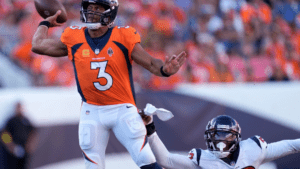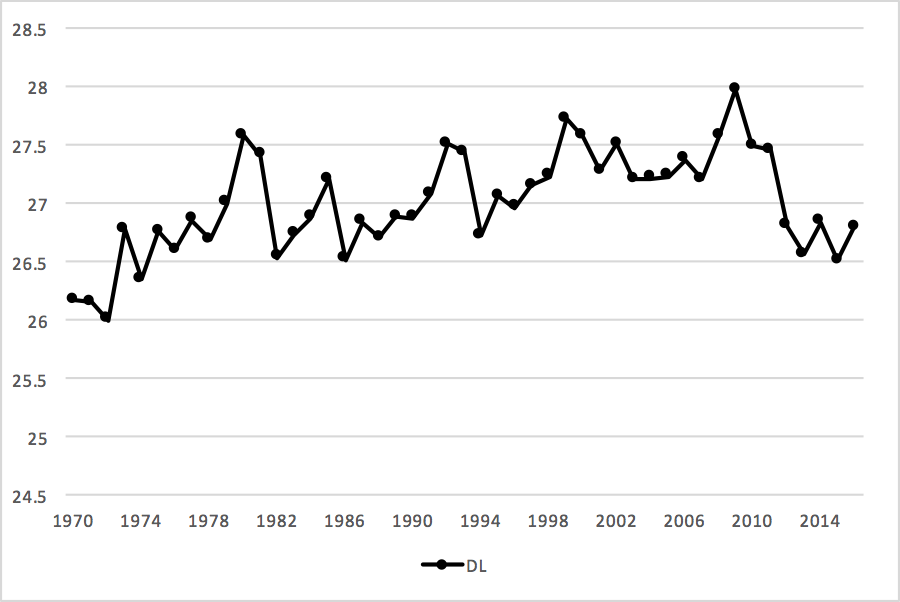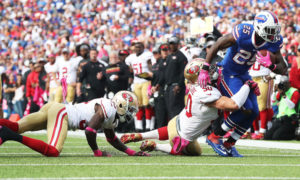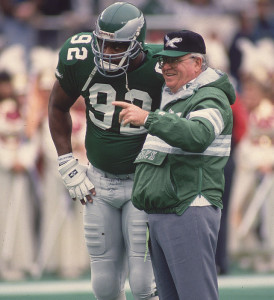Recently, I reintroduced the concept of adjusted sack numbers for individual player seasons. The logical next step, to me, is to take a look at those stats in the context of full careers. I liked the idea of presenting career data in terms of per-500 dropback metrics and cumulative totals. On top of the methodologies we discussed in the last post, I also wanted to introduce two new ways to look at the information. I hope it proves interesting, and I apologize in advance for my spectacular inability to come up with better acronyms, initialisms, and abbreviations.
Normalized for Volume
The table below contains every player in history with at least 30 sacks (or 30 in the last column) since 1960. Read it thus: Deacon Jones played in 191 games and recorded 173.5 sacks against 5891 dropbacks. His 2.95% career sack rate means he was good for 14.7 sacks per 500 dropbacks over the course of his entire career. If we take his sacks per 500 dropbacks totals from each season and add them together, we get 203.3, which is easily the highest mark ever.
As you probably expected, older players and T.J. Watt dominate the S/500 column. Guys like Robustelli and Marchetti played against offensive linemen hamstrung by rules, while Watt is a quarterback killer still in his prime. When we look in the last column, we can see how much the small differences in each season add up to a big gap between Bruce Smith and Reggie White. Three members of the Purple People Eaters appear in the top eight, though one guy took an additional sixty-ish games to get there.
Also, is it possible that the Hall of Fame actually doesn’t like pass rushers as much as people think?
League Environment Incorporated
In order to account for the easier environment for getting into the backfield long ago, we will use the modified and soft-modified conversions we used in the last article. The table contains any pass rusher who recorded at least 30 actual sacks or reached 30 in either of the last two columns. Read it thus: Alan Page played 218 games and recorded 148.5 sacks against 6348 dropbacks, which is good for a rate of 2.34%. His modifier is worth 91.5%, which becomes 95.7% when softened. For his career, he had 10.7 modified sacks per 500 dropbacks and 11.2 soft-modified sacks per 500 dropbacks. If we take the cumulative totals of those two stats, Page had 160.7 and 169.9, respectively.
When we look at the Soft500 column, we get a fun mix of characters. The Deacon is on top, followed by the younger Watt. Then we get another legend followed by another guy with scant games under his belt. Marchetti and Robustelli have a significant chunk of their careers omitted from this study because Turney and Webster haven’t finished their work on pre-1960 sacks, but the fact that they rank so highly on a per season basis despite not having years prior to their mid-thirties demonstrates how apt they were at pass rushing.
Alex Karras probably would have been in the Hall of Fame earlier were it not for his gambling controversy, while Claude Humphrey likely belongs on more lists of greatest pass rushers. Watch his tape, and you’ll see a guy whose athleticism stands out in the same way that Len Ford‘s did earlier or Julius Peppers‘s did later. Coy Bacon ranks tenth in the SoftTot column. He is a mere 4.3 below Jim Marshall, despite appearing in over one hundred fewer games.
Concentration Accounted For
Now it’s time to take pass rushing depth into consideration by applying a league concentration adjustment to each player. Here’s how to read the table, using Reggie White as an example: White’s career concentration adjustment is worth 1.036, meaning he gets a 3.6% boost to his stats from previous steps. For comparison’s sake, he had 198 actual sacks. When applying the concentration adjustment to his sacks per 500 dropbacks, his number comes to 11.7. If we include the modifier for league sack environment, that number jumps to 12.1. Softening that modifier brings his number down a bit, this time to 11.9. When we add all of White’s single-season figures in concentration-adjusted sacks per 500 dropbacks, his career total is 177.7. The cumulative number for the modified version of that comes to 181.1, and the softened iteration totals 179.4.
The thing that stands out to me is the placement of John Abraham. He is tied for eighteenth on the official sack list but jumps to thirteenth when sorting by the penultimate column. Abraham made five Pro Bowls and three all pro first teams, which doesn’t scream “Hall of Fame,” but he had eight seasons with double digit sacks and two more seasons in which he missed games but still notched 9.5 sacks. In 2003, he played in just seven games but managed 6 sacks. Had he stayed healthy in 2003-04, he likely would have had five consecutive seasons with 10+ sacks after becoming a starter. Abraham was a few injuries away from retiring with eleven seasons in the double digits. I remember watching footage of the highly celebrated Robustelli and thinking his postseasons honors indicate a Reggie White level of play but the tape suggested he was more akin to John Abraham. The per-season numbers in this table support that notion. If the second best Bengals cornerback of the 1970s can make it to Canton, maybe Abraham has a chance at a senior nod one day.
Dominance Exalted
The table below displays what I think is a more accurate representation of what we think about when we think about great pass rushers. Instead of career compilation, we’re looking at career value over a given baseline. Read the table thus: Jack Youngblood played in 202 games and recorded 151.5 sacks. For his career, his sack rate was 1.04% better than the league baseline, giving him 5.2 extra sacks per 500 dropbacks. When summing his individual seasons in that metric, he was worth 74.3 sacks above baseline. If we apply the concentration adjustment to his career numbers, he was worth 69.8 added sacks. When we get rid of all seasons that are below average and look only at what might be considered peak production, Youngblood’s value jumps to 72.4.
This table is a numeric representation of why Jim Marshall can rank 23rd in career sacks and not make it to the Hall of Fame. For his career, he was barely above the baseline, meaning he was ultimately worth about 19 extra sacks. Compare that with Bacon, who shares a ranking on the unofficial career list. Because his sack performances were more dominant, his career sack value is 54.7, which puts him in elite company. Cedrick Hardman, Simeon Rice, Harvey Martin, and Jack Gregory are a few other players who stand out as dominant sack artists who may be underrated now.
Something New
I figured I would throw in a few new concepts just to round out the discussion. I have long been a fan of Pro Football Reference’s passing index scores, and I have created my own versions of them for several different stats. This time, I applied the methodology to defensive sack rates. Also, because the results of the single season and career numbers still seem to favor older players, despite the entire purpose of this exercise being to translate across eras, I wanted to incorporate the league strength modifiers I have been working on for the past several years. People who lament that football today isn’t like the football idealized by marvelous NFL Films creations may not like this.
The below chart shows every player with at least 3000 dropbacks faced. Using Jared Allen as an example, read the table thus: Allen had 134 sacks against 6426 dropbacks for a 2.09% sack rate. His sack rate was nearly a full standard deviation above the median, giving him a sack rate+ of 113.5. His concentration-adjusted career sack value, after accounting for league strength, is 61.1. When we look at only his positive value seasons, it raises slightly to 61.7.
I believe the top ten, as ranked by the last column, is a great list of stellar sacksmiths. A decent era range shows up, and there doesn’t seem to be too much skew toward older or newer players. However, this may be because it more closely lines up with my subjective view of these players, and we love to have our priors confirmed.
The lowest ranked players on the list are linebackers who had a decent number of sacks but played in coverage too often to reasonably compete with edge rushers, as well as interior linemen who played a ton of snaps but weren’t primarily pass rushers.
What stands out to you?
 In 1946, the Pittsburgh Steelers went 5-5-1. While the sum of the team’s parts may have been perfectly average, their components were far from it. The head coach was newly-hired Jock Sutherland, who had been a local hero after taking the Pitt Panthers to four Rose Bowls. After a stint in the Navy during World War II, he returned to the city and coached the Steelers for two seasons, beginning in 1946. In the 10-team NFL, Pittsburgh allowed the fewest points in the NFL at 10.6 per game, a mark that would not be matched again until the Lombardi Packers in 1962. The NFL average in 1946 was 18.9 points per game, and every other team allowed at least 14.4 points per game. Unfortunately, the Steelers offense was as bad as the defense was good: the black and gold finished last in the league in scoring at 12.4 points per game.
In 1946, the Pittsburgh Steelers went 5-5-1. While the sum of the team’s parts may have been perfectly average, their components were far from it. The head coach was newly-hired Jock Sutherland, who had been a local hero after taking the Pitt Panthers to four Rose Bowls. After a stint in the Navy during World War II, he returned to the city and coached the Steelers for two seasons, beginning in 1946. In the 10-team NFL, Pittsburgh allowed the fewest points in the NFL at 10.6 per game, a mark that would not be matched again until the Lombardi Packers in 1962. The NFL average in 1946 was 18.9 points per game, and every other team allowed at least 14.4 points per game. Unfortunately, the Steelers offense was as bad as the defense was good: the black and gold finished last in the league in scoring at 12.4 points per game.






